Estate Jewelry: Dead Cromwell Edition
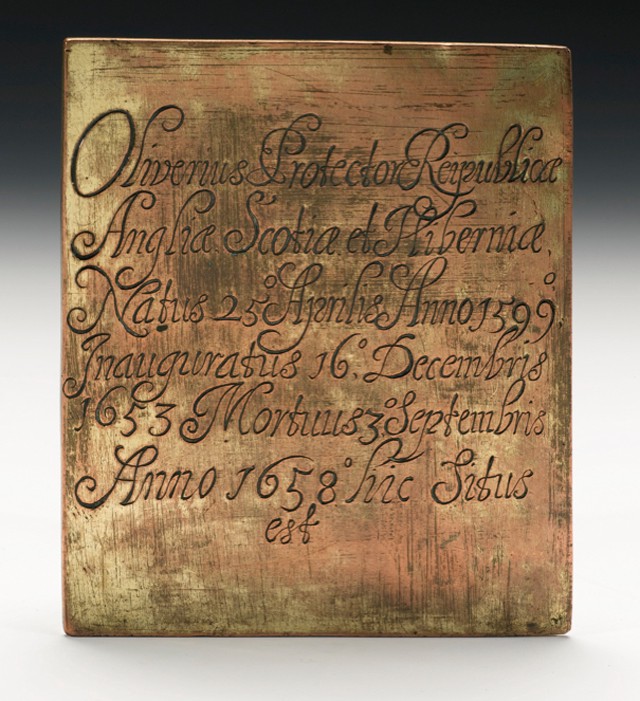
Hi all, it’s auction time! And I know this piece isn’t jewelry, but it’s such a fascinating bit of history that I have to include it: It’s the coffin plate of Oliver Cromwell, the former Lord Protector of England.
Cromwell died on September 3, 1658. He was given a funeral fit for a king, but because his body had been badly embalmed, it started to decompose (“It purged and wrought through all,” ew), so a life-like effigy of Cromwell was created to lie in state instead. His actual body was interred in Westminster Abbey weeks before the official state funeral (on November 23, 1658) took place, and the preparation of both his body and his coffin followed the orders of the Privy Council: “His Highness Corps being embalmed, with all due rites appertayneing thereunto, and being wrapped in Lead, There ought to be an Inscripcion in a plate of Gold [Sotheby’s notes that this does not necessarily mean actual gold, but instead any gilded metal] to be fixed upon his Brest before he be putt into the Coffin. That the Coffin be filled with odours, and spices within, and Covered without with purple Velvett, and handles, Nayles, and all other Iron Worke about it, be richly hatched with Gold.” (Order Book of the Privy Council, 14 September 1658, quoted in Cromwell’s Head [2008] by Jonathan Fitzgibbons, pages 37–38).
The piece on auction is the actual “plate of Gold” that was placed on Cromwell’s breast and buried with him. It didn’t stay there long, however…
After the restoration of King Charles II in 1660, anyone who had participated in the trial and execution of Charles I was rounded up and executed. Three of the men involved — including Cromwell — had already died previously (how dare they!), so their bodies were exhumed for posthumous execution (that’ll show ‘em!). Cromwell’s body was disinterred in January 1661 by James Norfolke, a Serjeant of the House of Commons. Norfolke found the plate resting on Cromwell’s chest in a case of lead, and kept it. The plate was then passed down through his and various other families, and it’s now up for sale in the Sotheby’s “English Literature, History, Children’s Books and Illustrations” auction in London today.
The plate is made of gilded copper, and engraved with a Latin inscription that lists the dates of his birth, inauguration as Lord Protector, and death, as well as the Arms of Cromwell’s government, the Protectorate. It has a fairly low estimate of $13k-20k; auction houses tend towards conservative estimates on one-of-a-kind historical items such as this, because it’s impossible to predict how much someone may (or may not) be willing to pay for history.
Macabre side note: Cromwell’s exhumed corpse (and those of his two fellow already-dead regicides) was hanged, drawn and decapitated. Samuel Pepys, bless him, was there, and mentions it in passing in his diary. Cromwell’s head — which has a Wikipedia page of its own — was then stuck on a 20-foot pole above Westminster Hall, and it remained there for over 20 years until it was blown down in a storm and confiscated by a sentry, who, according to Fitzgibbons, hid it in his chimney. (You can see a photo of it, still embedded on its broken bit of pole, here.) The head was then passed down through various owners until 1960, when it was buried in an unmarked location in the ante-chapel of Sidney Sussex College (the college Cromwell himself had attended), Cambridge.
Ok, on to the jewelry!
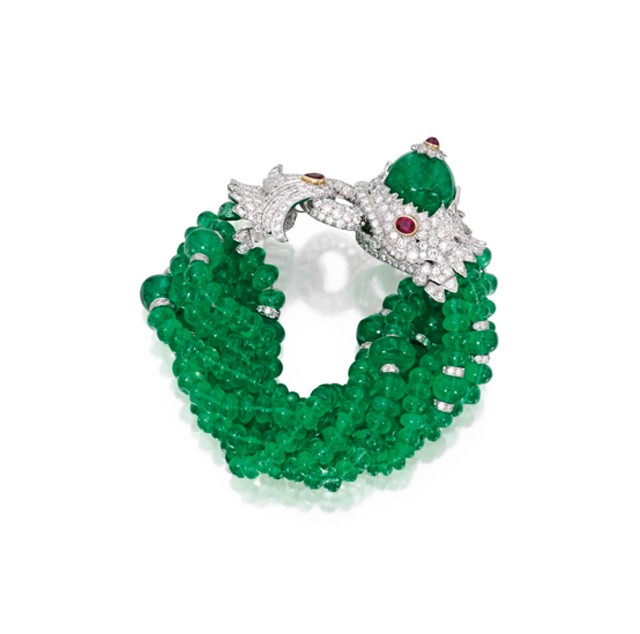
The Sotheby’s Magnificent Jewels auction taking place today in New York City is (as always) loaded with big, glam pieces, including this amazing David Webb dragon bracelet. In platinum and 18K gold with seven strands of emerald beads, the piece features a diamond-set clasp in the form of a dragon’s head, with an emerald bead crown and cabochon, oval and pear-shaped ruby accents.
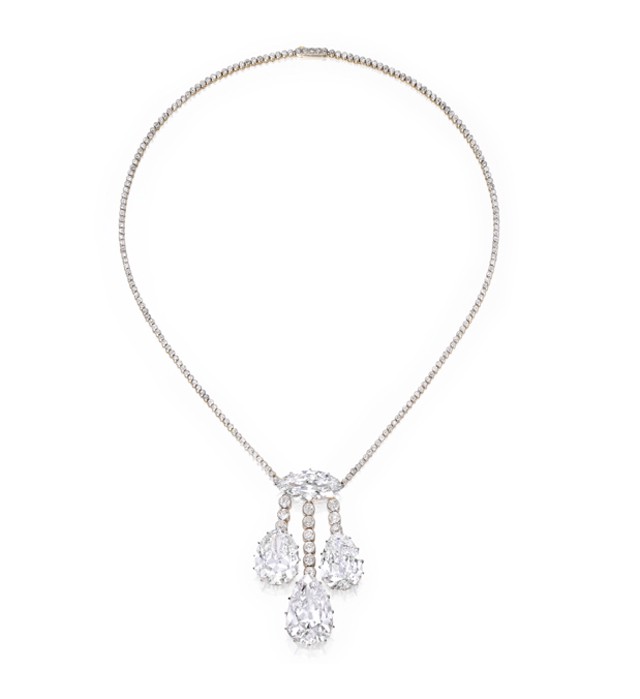
This circa 1902 necklace is one of the highlights of the auction, and even though I’m not a big diamond person (unless they’re colored; colored diamonds are amazing), I like it. It’s platinum, with a center 8.91 carat marquise-shaped diamond that supports three giant pear-shaped diamond drops. The central diamond weighs in at a whopping 27.48 carats, and the stones flanking it are 15.53 and 13.08 carats. A further 6.65 carats of old European-cut diamonds line the bars supporting the drops. The piece is estimated at a trifling $2.5–3.5 million.
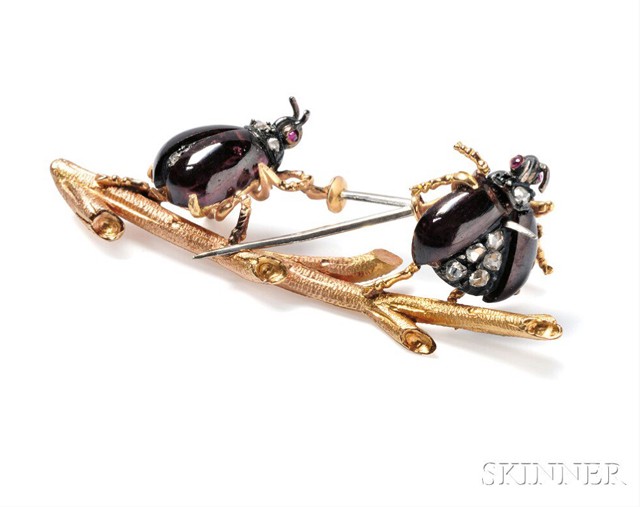
Skinner is also holding an auction today in Boston. “Fine Jewelry” runs the gamut from high-end diamonds to fun, oddball pieces, and this brooch, depicting a duel to the death between two beetles, is a perfect example of the latter. The beetles stand on a gold branch, and have diamond-set bodies with garnet wings and eyes. One of them is missing a rose-cut diamond. What do beetles duel about, I wonder? Perhaps one beetle disparaged the size of the other’s dung ball.

Ok, let’s just shake off the words “dung ball” and move on to some very pretty, understated earrings. By Cartier, they’re Edwardian, and feature approximately 10.50 carats of diamonds set in platinum. The pear-shaped drops are suspended from millegrained (i.e., the tiny beaded detail that runs along the outside edges of the platinum) tops in a scroll design set with old mine and old European-cut diamonds. They’re 1.25 inches long.
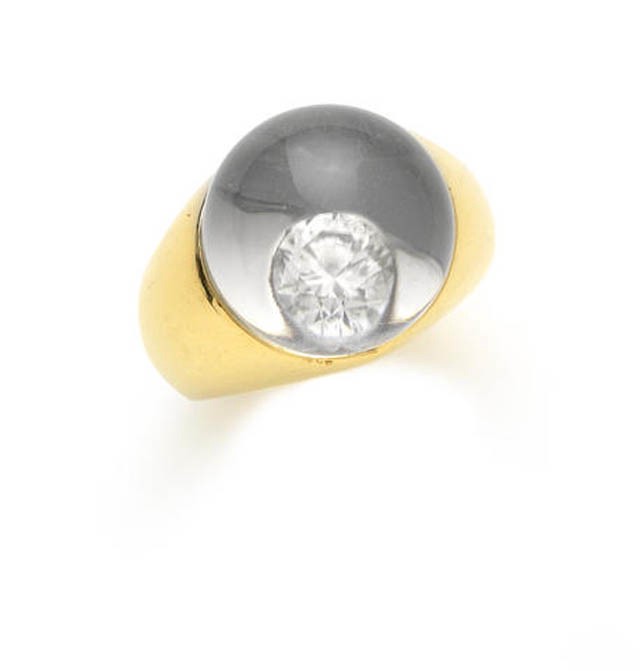
On Wednesday, December 10, Bonham’s in London is holding a couple of interesting auctions. The “Jewellery” auction will include this ring by the venerable (established in 1827) French jewelers Mauboussin. It’s a “crystal ball” ring, with a rock crystal dome placed above a brilliant cut diamond, and the whole thing set in yellow gold. The crystal magnifies the diamond within. I’ve seen both vintage (1960s) and contemporary versions of this ring online, but Bonham’s hasn’t provided a date for this one. What do you think? Interesting or horrible?
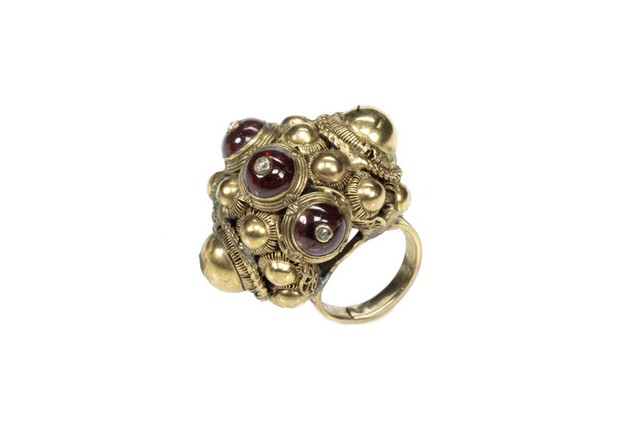
Also at Bonham’s London is an “Entertainment Memorabilia” sale, featuring movie and music posters, costumes and ephemera. This piece stands out: it’s a giant costume jewelry ring that was worn by Katherine Hepburn in her role as Eleanor of Aquitaine in the 1968 film The Lion in Winter. In gold metal with three unidentified-stone cabochons set alongside similarly rounded gold forms with wirework detailing, the piece comes with a photo of Hepburn on set with the ring prominently displayed on her hand, as well as other Hepburn and Lion in Winter-related ephemera.
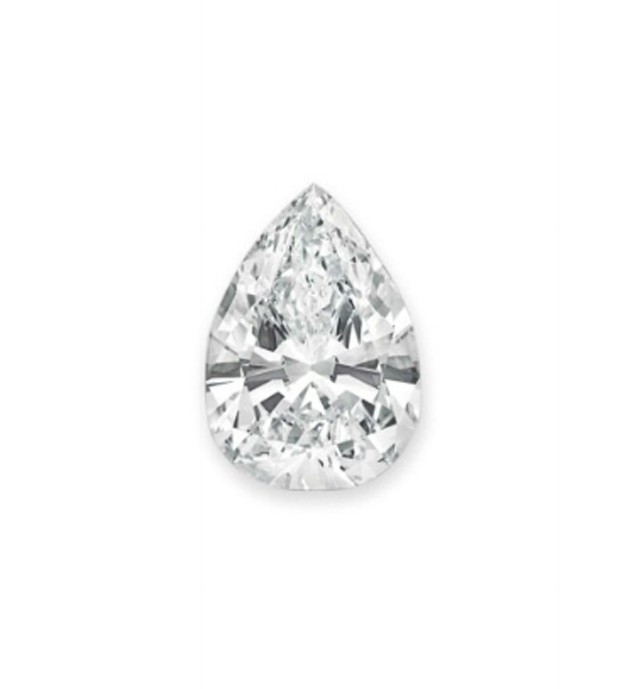
Also on the 10th is the Christie’s “Magnificent Jewels” auction in New York. Here we have more big diamonds, and in particular a HUGE 89.23 carat certified Type IIa pear-shaped diamond that’s set in platinum. It’s listed as “estimate upon request” (otherwise known as “haaaahahahaha yeah right”), but is expected to sell for more than $10 million.
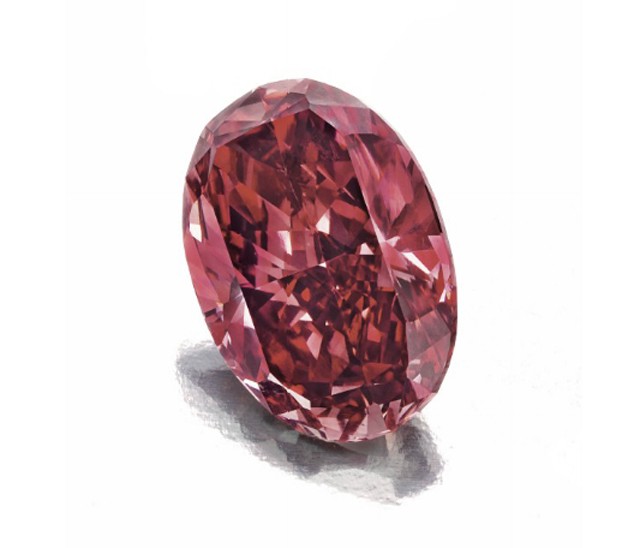
There’s also a gorgeous colored diamond available in this sale. It’s an unmounted oval-cut fancy red diamond, weighing approximately 1.42 carats, and it was sourced from Rio Tinto’s famous Argyle Diamond Mine in Western Australia. Over ninety percent of the world’s pink and red diamonds come from the Argyle mine, and each year the best stones are set aside for sale in the exclusive Argyle Pink Diamonds Tender. This particular stone was included in the 2013 Tender, and is estimated at $1.5–2.5 million. You can see some of the stones featured in this past October’s 2014 Tender here.
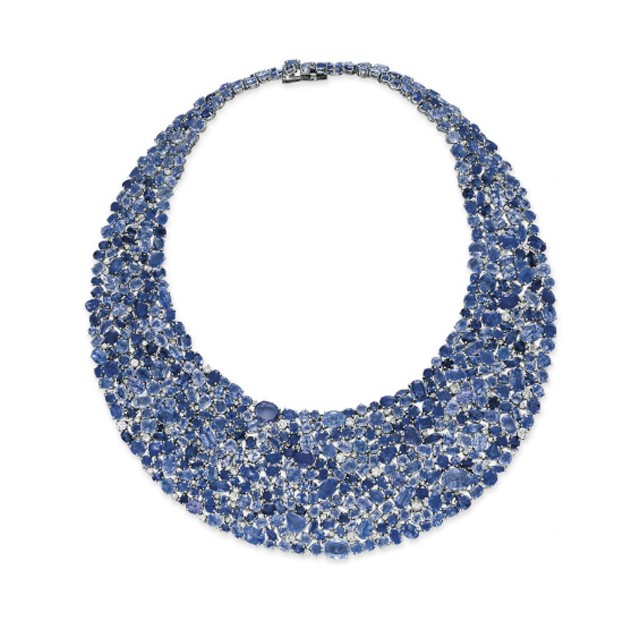
Another impressive piece is this bib necklace by Michele Della Valle (the creator of the lily of the valley necklace I featured in a previous column). Comprised of loads of sapphires in various cuts — with some circular-cut diamonds and oval-cut purple sapphires thrown in for variety — the piece is called a “bib” necklace for obvious reasons. The stones are set in 18k white gold.
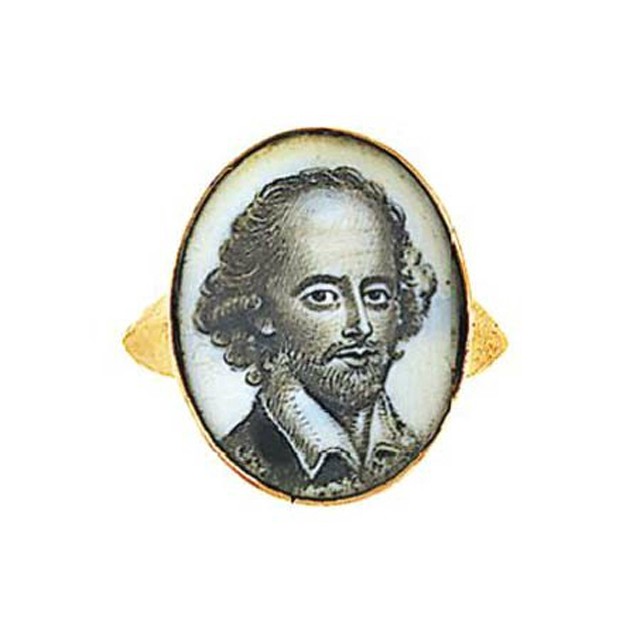
The Christie’s London branch will hold their “Jewellery” auction on December 11. This sale has some interesting, less-blingy pieces, including this late 18th/early 19th century mourning ring, featuring a portrait of William Shakespeare on ivory.
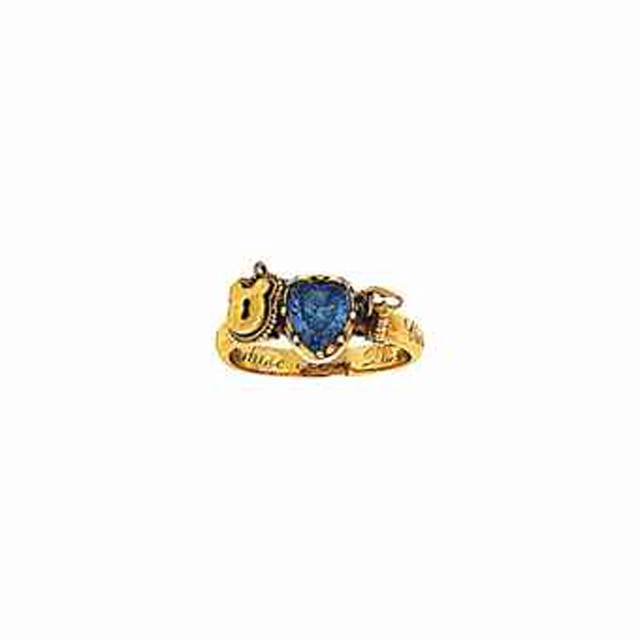
Another interesting piece is this early 19th century sentimental locket ring that references Caroline of Brunswick, the former Queen of England. Caroline was queen for just a short amount of time, but her 1795 marriage to George IV (then the Prince of Wales) was a rocky one. It was an arranged marriage that neither of them were particularly thrilled about to begin with, and the pair eventually separated — although they were together long enough for Caroline to give birth to a daughter, Princess Charlotte of Wales, also in 1795. Caroline lived abroad for years, and George, despite having a long list of mistresses, had her investigated twice for adultery in the hopes of securing enough evidence for a divorce. His campaign against Caroline only served to increase her popularity with the English people, who saw George’s accusations as hypocritical. There’s a good illustrated history of their marriage here, which includes a staunchly pro-Caroline quote from Jane Austen: “Poor woman, I shall support her as long as I can, because she is a Woman and because I hate her Husband.”
This ring places a heart-shaped sapphire between an articulated padlock and key. The outside of the band is engraved “Queen Caroline of England 1820,” while the inside bears the words “Franchise et Discrétion.” 1820 was the year George III died, and Caroline returned to England to claim her rights. Her return was cheered by the English people, but her husband continued his efforts to get rid of her by trying to get a Parliamentary bill passed that would strip her of her title and annul the marriage. Circumstantial evidence was brought against Caroline to “prove” her adulterous behavior — and while it was probably true that she had flagrantly maintained a relationship with a strapping Italian soldier, the case eventually became so distasteful and unpopular that the bill was withdrawn due to a lack of support in Parliament.
Lock-and-key jewelry motifs were a very popular symbol of love and commitment during the late 18th-early 19th centuries, so combined with the 1820 date, this ring may have been created as a show of support for Caroline. Her story ends sadly, though, as she was physically barred from the doors of George’s coronation in 1821 (seriously, the man was such a turd), and died less than a month later of an abdominal illness.
Note: A BBC film about George and Caroline came out in 1996 called A Royal Scandal. It stars Susan Lynch and Richard E. Grant (with narration by Ian Richardson), and while I haven’t seen it, the image of a bewigged and scowling Grant is more than enough to make me track it down.
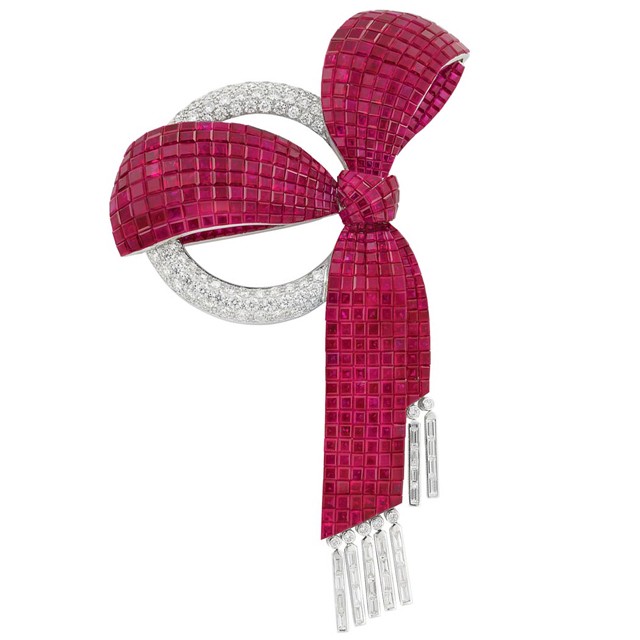
Also on December 11 is the “Important Jewelry” auction at Doyle New York. This brooch jumped out at me as an excellent example of the “invisible setting” technique of placing gemstones. Invisible setting means just that — there are no prongs to be seen, so how do those stones stay put? It’s actually pretty simple: Grooves or notches are cut into the base of the gemstones, allowing them to slide or fit into a metal support structure that holds them in place. With no intrusive prongs separating them, the stones can be placed flush against each other, resulting in a dense, rich area of color. The technique was developed in France in the mid-19th century, but you’ve probably seen it in the jewelry of Van Cleef and Arpels, who patented their own version of the technique — the Mystery Setting™ — in 1933.
This particular brooch features a diamond-set circular form tied with a large bow of invisibly set square, rectangular and fancy-shaped rubies. A fringe of diamond baguettes hangs from the bow. The solid carpet of raspberry color created by the invisibly set rubies is so saturated and dense it’s gorgeous.
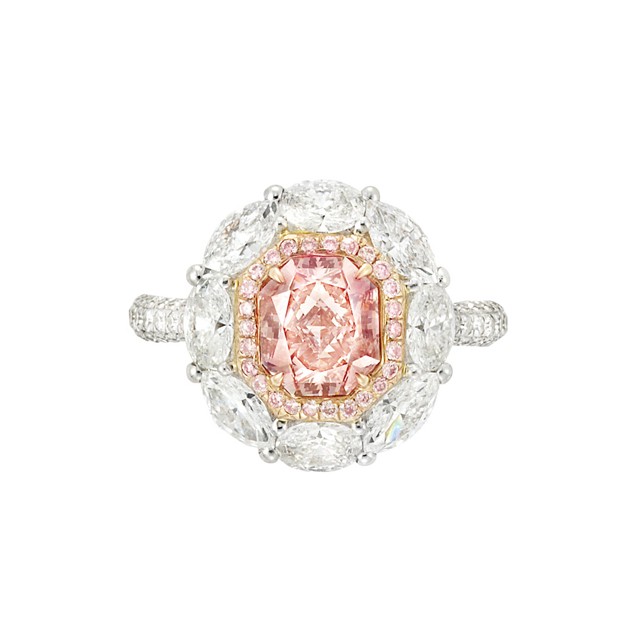
This diamond ring is one of the higher-end pieces in the sale. It features a central 1.72 carat fancy orangy-pink diamond surrounded by 26 tiny round light pink diamonds. Eight oval and marquise-shaped diamonds finish the frame, and part of the band is pavé-set with more diamonds. The estimate is $100,000–150,000.
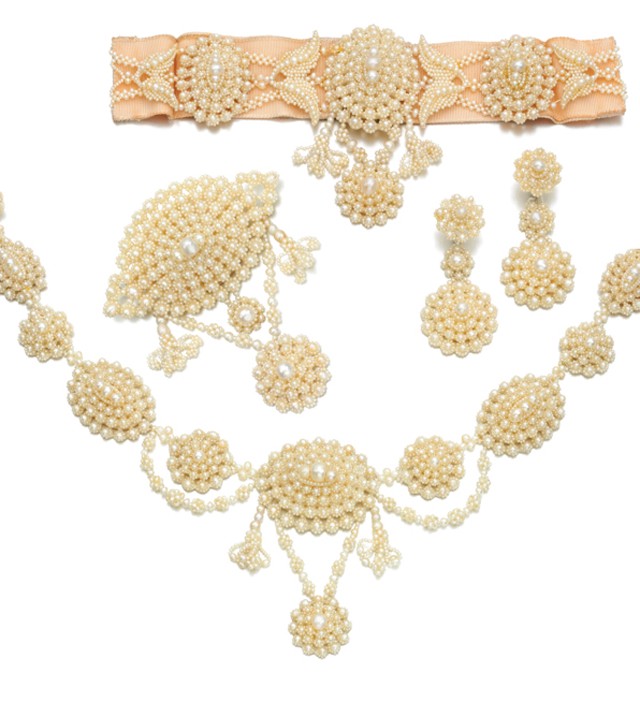
Sotheby’s will hold another auction, “Fine Jewels,” in London on December 16. A notable piece in this sale is this seed pearl parure, comprised of a necklace, brooch, earrings and a collier (a choker or dog-collar-style necklace). This set is interesting because it dates to the 1850s, and it was made by Tiffany & Co. Tiffany only opened in 1837, so it’s great to see an example of their early product. The auction literature also mentions that Abraham Lincoln bought a similar parure from Tiffany & Co. in 1861, which his wife Mary Todd Lincoln wore to his inauguration. You can see some photos of Mary actually wearing the set here.
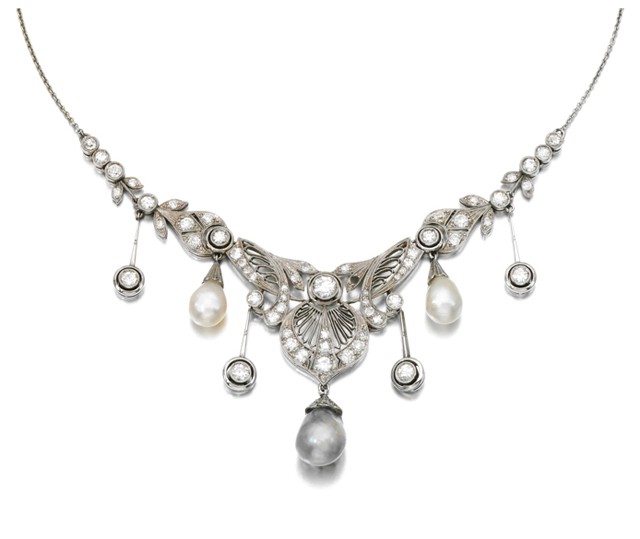
Chalk this one up in the “just really pretty” category. Circa 1915, this necklace features an open scrollwork design that is set with circular- and single-cut diamonds, with three natural saltwater pearl drops. One of the smallest diamonds is missing.
Monica McLaughlin tweets at @rococopacetic. She also recently saw the exhibit “Treasures from India: Jewels from the Al-Thani Collection” at the Metropolitan Museum of Art and HIGHLY recommends it. It will be up until January 25, 2015, so if you’re in the area, go! And if you’re not, click through to look at the individual pieces on display.